Do you have a difficult time finding activities to keep other students engaged while you are teaching small group reading lessons? If so, you’re not alone! Many teachers feel this way. It can be a challenge, but it doesn’t have to be! Today, I am sharing reading centers and activities (with lots of free activities) that will keep your other students engaged and reading while you pull students for small group reading instruction.
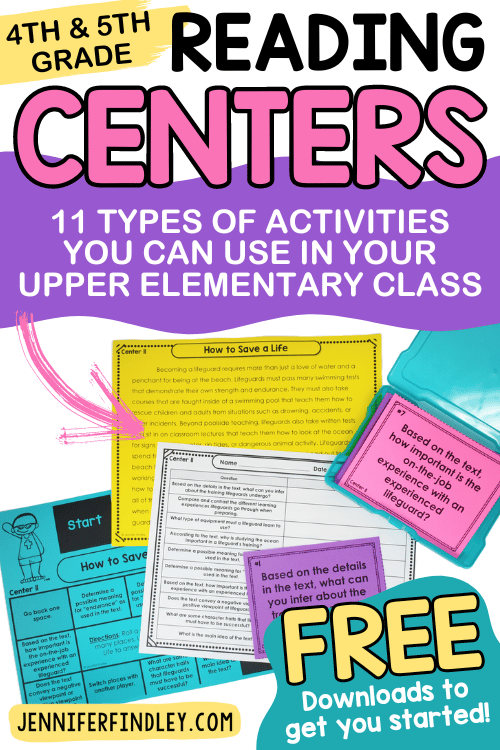
4th and & 5th Graders Are Not Too Old for Reading Centers
If you’re like most teachers, when you think of reading centers, you probably think of primary grades. However, reading centers can be beneficial for students in upper grades, too! In fact, many 4th and 5th grade teachers use reading centers on a regular basis.
There are several reasons why reading centers can be beneficial for 5th graders:
1. They provide a way for students to practice reading independently AND with others.
2. Students are able to read at their own level and their own pace.
3. Reading centers give students the opportunity to explore different genres and reading topics that they might not choose themselves.
4. Strategically chosen reading centers allow students to continually practice and review reading skills and strategies
5. Reading centers engage all learners, including struggling readers and reluctant readers.
1. Independent Reading
Independent reading is an important goal for this grade level. Students in 4th and 5th grade really need to have the stamina to read for extended periods of time. Independent reading center is a center that ALL of my students complete each day and some complete this twice a day. For independent reading, the students read books of their choice while applying the reading skills from our reading mini-lessons.
To read about how I keep my students accountable for their reading, click here.
2. Reading Response Center – Write About Reading
This reading center goes perfectly with independent reading (and is one of the ways that I keep my students accountable for their independent reading).
There are many different ways that you can have students respond or write about their reading. Here are a few:
Reader’s Response Letters: One way that I implement reader’s response is by having my students write bi-weekly letters about the book they are reading. They either write to me in their reader’s notebooks, or they write to a partner via our class blog.
Book Reviews: Students can write short reviews of the books they read. This is a great way to get students thinking critically about what they are reading and share their reading with others.
Reader’s Theater: Students can create skits or plays based on the books they are reading. This is a great way to bring a book to life and to encourage student creativity.
Graphic Organizers: Students can use graphic organizers to organize their thoughts about a book. This is a great way to help students process what they are reading.
💡Click here to read more about these “write about reading” ideas and grab several freebies to implement in your classroom right away, click here or on the image below.
3. Reading Games
Reading games are a great way to keep kids engaged and excited about reading. They can also be used to teach and practice important reading skills, standards and overall comprehension. There are many different types of reading games and activities that you can use in your classroom, but here are a few of our favorites:
Reading Game Boards – These reading games include one-page grade level passages (helpful for building reading stamina) with an accompanying game board of text dependent questions. Sometimes we read the passage together as a class before centers start. Then, they spend the reading center time “playing” the game and answering the questions, which you can have them do orally or they could record them.
Want to try these reading games out in your classroom? Download a FREE reading game by clicking here.
Roll and Answer reading games- These centers include a half-page passage with 11 text-dependent questions. The students roll a dice twice, find the sum, and then answer the question that matches the sum. This can be “played” with partners (and even as a version of BUMP) or independently.
Want to try these reading centers out in your classroom? Download a FREE reading roll and answer center by clicking here.
4. Informational Text Center
Informational text is an important genre of writing for students to read regularly. When students read information texts, they are exposed to new vocabulary words, concepts, and ideas. They are also building their background and content knowledge.
Reading informational text also gives students the opportunity to practice reading skills such as main idea and details, sequence, and cause and effect. In addition, information texts often include illustrations and diagrams, which can help students visualize and understand the concepts being presented.
Because of this the informational text reading center is a very important addition to my reading center rotations. Through this reading center, I am able to expose my students to a variety of informational topics and a variety of different types of informational text.
I also use this center to both target my students’ interests and to integrate science and social studies into reading. Over the years, I have collected a library of books that align with our science and social studies topics. When I introduce a new topic, I pull out the books that match that topic and place them in the center.
I use my Roll and Answer Reading Response to have the students think about, discuss, and respond to their reading. You can read more about this reading center and grab it for FREE by clicking here.
5. Poetry Center
Similar to the informational reading center, I like to have a poetry reading center in my classroom to expose my students to a variety of poems.
For this reading center, I place a couple of poetry collection books and sometimes printed poems that I know my students will enjoy and poetry response task cards. During the center, the students read a poem and respond to the poem using the task cards.
Click here to get access to the FREE poetry task cards and response booklet.
6. Partner Reading
Partner reading center is one of my students’ favorite reading centers. It is also an effective way to improve reading fluency and comprehension, while also engaging students.
There are many benefits to using partner reading in your classroom, including:
1. It allows students to practice reading aloud with a supportive partner.
2. It gives struggling readers the chance to read with a more fluent reader.
3. It allows students to build stamina by reading for longer periods of time.
4. It gives reluctant readers the chance to read with a friend.
5. It builds confidence and motivation.
6. Students really enjoy it!
For my partner reading center, I like to mix things up and have several options. Sometimes my students simply read books together. Sometimes they read the same book and sometimes they read and discuss their own independent reading book.
You can read more about how I implement partner reading and grab a freebie on this post.
Partner reading is also a great center to have the students partner read grade level passages that target specific skills. I have found that my students who read a grade level below really benefit from reading grade level text with a partner in this format. They support each other and both students are exposed to more complex text.
💡If you need passages that target specific reading skills, click here to see my reading units that each contain several passages written specifically to target grade level reading skills.
7. Magazine Center
Magazines are always a hit with my students. They love the full color graphics and the variety of different high interest articles in the magazine. I usually have lots of magazines on hand from past subscriptions that I have paid for or were given to me. Check with your librarian for older magazines, too.
The great part about many magazines is they include comprehension questions and writing tasks to go with the articles. You could easily create a choice board with tasks for the students to complete. Here is a generic choice board that I use with my students when I don’t have time to create a magazine specific choice board or when the magazine, I am using doesn’t have a lot of comprehension questions/tasks. I just fill in the number of activities and articles required and copy it for my students.
💡 Click here to get access to the magazine reading center for free.
8. Targeted Short Skill Practice – Task Cards, Color by Reading, Etc.
Another popular reading center for upper elementary students are reading task cards or other reading activities with short texts. The short tasks and focused question that are used in these types of activities make them very accessible to all students, especially struggling students.
Click here to get access to a free set of Color by Reading practice for short-skill practice of identifying genre.
9. Digital Reading Centers
Since my students take their state tests on the computer now (with lots of typed responses), I like to get them on the computer as often as possible during reading time. There are several different types of digital reading centers that you can use depending on the needs of your students.
You can use:
- Self-Grading Digital Reading Google Forms
- Google Slides Activities with Text Boxes
- Google Slides Activities with Moveable Pieces
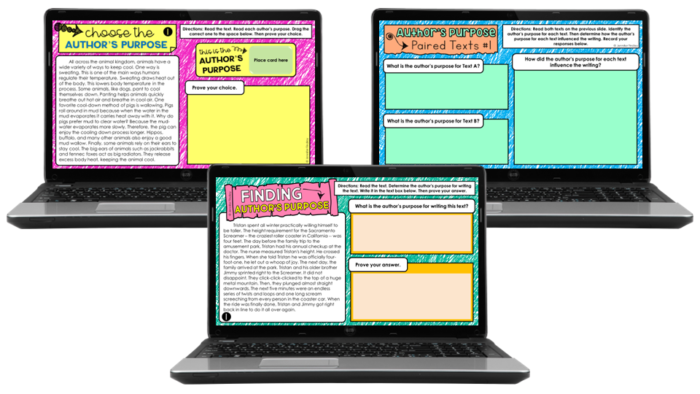
10. “Hands-On” Reading Activities
One thing that I have noticed instantly increases engagement and motivation is making activities hands-on.
However, this is not always easy with upper elementary skills and standards. To implement a bit of hands-on practice, I use reading puzzles, reading sorts, and reading spinners. These are perfect for short, but meaningful and highly targeted reading skill practice.
Want hands-on activities and reading centers? Click here to access the ones featured on this post.
11. Read Aloud Extension Center
I often begin my reading time with a read aloud (sometimes a chapter book like Wonder and sometimes a mentor picture book). As we read the book, we do lots of discussion and even writing together. I also like to give the students questions or a response to continue during their reading center time. You can see an example of this with the book The Wall by Eve Bunting by clicking here. I read the book aloud and have a mini-lesson with my students on a specific reading skill. Then, the task cards (that are free on the linked post) would be placed in a read aloud extension center for the students to complete that week.
Interested in learning more about the different read alouds I use in 4th and 5th grade? Click here to see all of my blog posts that share the different read alouds and mentor texts for a variety of skills and even holidays.
Access Exclusive Email Reading Centers HERE
If you missed any of the links to the reading centers shared on this post (that are email exclusive), just click on the GIF below and enter your email on the page to get instant access!
FAQs About Reading Centers for Upper Elementary Students
- Do you use all of these reading centers? No, I don’t use all ten of these reading centers at one time and some don’t ever make their way into my reading time over the course of a year. It really depends on my students, their interests and their existing reading behaviors and needs. The reading centers you choose to use also depends on your available resources and how you teach reading.
- How many centers do the students complete a day? My students complete 2-3 reading centers a day. One of their reading centers MUST be independent reading.
- How long do your reading centers last? Each center lasts approximately 20 minutes. I am very strict on my students beginning their center immediately once we transition since our time is limited.
- Do you assign reading centers or allow the students to choose? I have done both ways. It really depends on your students and their maturity levels, behavior, and motivation.
- How do you handle behavior during reading centers? I teach the reading centers explicitly and teach/model the proper expectations for the quality of work and their behavior at the center. I spend the first month of school doing this. By doing the work upfront, I have minimal issues with behavior throughout the year. Also, the consistency of the reading centers also helps with behavior. They know exactly what is to be expected of them at each center. Click here to read a more detailed post about reading center management.
Want more articles about reading and freebies?
If you are still on the fence about whether or not reading centers will work with your students, click here to check out this post for five reasons to use reading centers in upper elementary. The post also shares a free paired passage reading center.
Do you love reading centers but struggle with classroom management during reading center time? Check out my tips for reading centers management by clicking here.
If you would like to read about how I teach reading, click here to read a detailed breakdown of what reading instruction looks like in my 5th grade classroom.
Do you use any of these reading centers with your upper elementary students? Do you have another reading center that you use and love? I would love to hear about it in the comments.

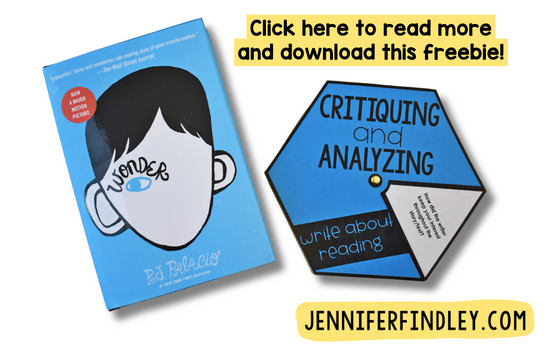
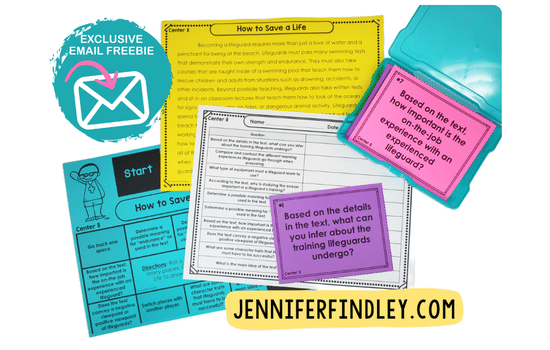
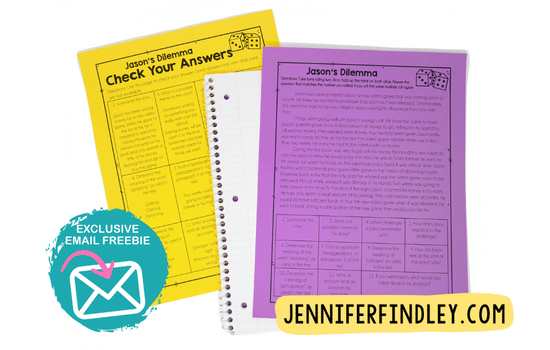
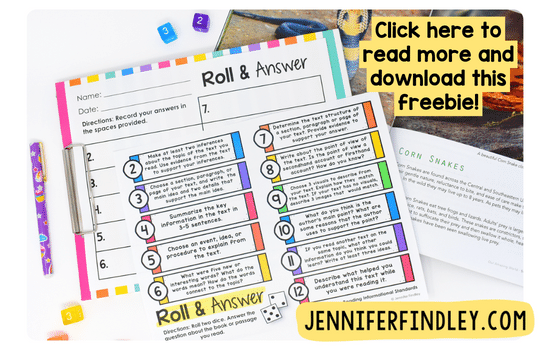
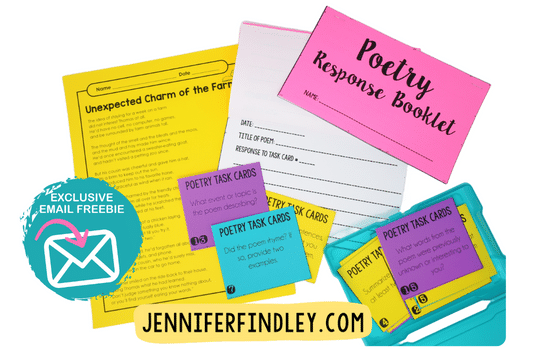

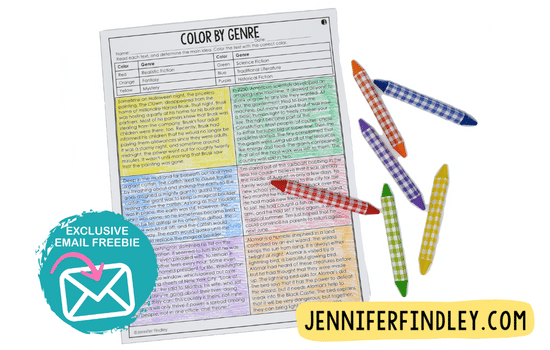
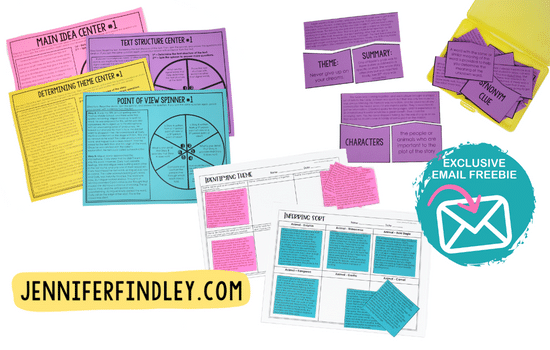








Loved reading this post. Thanks for sharing some new and fresh ideas that I will be able to integrate in my own classroom during reading centers!
You are welcome, Alison! Thank you for visiting my blog!
Hi! I love your resources! I teach third grade, do you have any bundles for literacy centers for third grade??
So glad I stumbled upon your blog! I have struggled to make guided reading work well in my classroom. I am excited to use your ideas this fall! Amazing! Thank you!!
Glad to have you here, Mary! Guided reading can definitely be tricky to get going with some classes. Let me know if you have any questions. I hope you have a great summer!
This is a great post! Thank you for pulling all the ideas and activities together in one place. I love how you have diversified your centers to incorporate all kinds of reading. I’m saving this for reference. Awesome!!
Thank you! Diversifying my centers to expose my students to a variety of genres and types of text is definitely my end goal!
Good O
Thank you so much! I’ve been struggling with ways to change my reading time and this post was everything I was attempting just simplified (I tend to over think everything) and perfectly timed! Thank you!
You’re welcome, Angela! I hope it helps you!
I’m going into my first year teaching and I’ve landed a position in 5th grade ELA. I’m very excited and this is really helpful. Thank you fro taking the time to put together such a valuable resource!
How do you manage your student’s work and provide feedback? Do they turn in work daily or weekly? Do you grade and return everything? This is my biggest challenge with reading centers.
Hi Mallory, yes, this can be a challenge. If I give my students a read aloud extension, I will definitely take that up and daily if possible. The other poetry and magazine reading centers are taken up biweekly. For the reading games, my students write on marker boards or just discuss the questions so nothing is graded. If I was worried about accountability, I would have them write their answers on paper and turn them in. However, the games are motivation enough. As I mentioned in the post, I don’t have all of these centers going on at the same time, so it is not as time consuming to grade at all. I hope this helps!
I. Love. Your. Blog. I am so glad I found this. I have taught 4th grade for 11 years and am moving to 5th grade this year. Thank you so much for sharing!
You are very welcome, and thank you!
Thank you for this post! I’m returning to 7th grade ELA this fall after 8 years of central office work and your ideas have been very inspiring! I’m looking forward to using them in my classroom.
Enjoy your summer!
Thank you! Enjoy your summer as well!
Thank you so much for this awesome post. I was wondering how long of a reading block do you have? How much time would you spend whole group before students go to centers?
Hi April, I have always been blessed with a 90 minute reading block. I spend about 20 minutes of that on a whole group lesson/read aloud. You can read more about my reading block here:
https://jenniferfindley.com//2016/07/how-i-teach-reading-in-5th-grade.html
Thanks!
I use partner reading often!
Thank you! I am moving from first grade to fourth grade. I have always used stations in some format (Daily 5 and Deb Diller). . I know they are beneficial and I am excited to use stations with students who are more independent. I’ll be following you closely! Thank you for sharing!
How do you organize and distribute the materials for the centers? Tubs? Leave them at tables?
I’ve struggled with wasting time on setting up materials for centers daily and wondered if you had a solution?
Hi Angela, I typically only have 2-3 centers going on at a time. Independent reading is always a center and requires no materials on my part. The other centers are kept in baskets or tubs and stored on a shelf until center time. Then I just pull them out and place them in the station area. The same center will stay out for a week to two weeks, so I am not changing things out constantly. The only centers I change out more frequently are the reading games and those are pretty use to change out with little prep on my part. The poetry center requires only a basket of poetry books and the students keep the booklets with them. The magazine center is the same with the students keeping the choice board. The informational center “game” is prepped only once and then the books are changed out. The centers that I like to use are relatively low prep to avoid wasted time. I hope this helps!
How do you keep track of what centers the students have completed. This is my biggest struggle. Knowing where to send each student. I really want them to know what center they should be completed each day without me telling them. Do you make sure every student goes to the same centers every week?
Thanks for you blog! My mind is going crazy with all the great ideas! My TpT wish list has tons of your products! I can’t wait to start buying some of them and using them!
Hi Sarah, I have used chart paper before for the rotation and sometimes I have just written on the board. I have some centers that are staples, such as independent reading and reading response center. For the other center I will choose one of the other ideas. I typically only have four centers going, guided reading included. I have about five reading groups in my room so I usually have two groups doing independent reading at a time. I do make sure that every student goes to independent reading once a day, and then alternates the other centers. Their reader’s response letter are due every other week (half the students one week, and the other half the next) to help with grading so it is not necessary that they go to that center every day. Hope this helps!
Love your suggestions! To add to the previous questions, how do you track their completed work such as Poetry task cards, etc.?
Jennifer, I have enjoyed reading your blog. You have some many great ideas! My question is similar to Sarah up above. How do you assess your reading centers? Do you pick one center to grade, so that the students are held accountable to complete them all? Also, how do you have the students organize their centers? I will sometimes have them carry a center folder, along with their composition notebook.
Thanks!
Hi Angie, I do assess some (but not all of the centers). I assess independent reading through reader’s response letters. Their reader’s response letter are due every other week (half the students one week, and the other half the next) to help with grading on my part. Then I usually only have 1-2 other centers going on. I don’t typically grade the game center or the partner reading center, unless I need to add in that accountability piece to ensure the students are working. I do take a grade on the poetry booklet and magazine choice board but those centers are not in my regularly weekly center rotation. My students typically only take their reader’s response notebook and books they are reading to their centers. My students have book bins so they store their materials in there. Hope this helps!
Hi! I can’t wait to try out all of these great tips!
I just have one question…
Do you have a template as to grouping and scheduling the small group guided reading time?
I’m curious of some of the read alouds you do for elements such as story structure, theme, main idea, etc. I am a new teacher and having trouble finding good quality read alouds that are enjoyable and interesting.
I am thinking about trying these with my 3rd graders. Have you heard of others in third grade having success with these? I think they sound great and really appreciate your hard work and sharing these!
My team reading teacher is retiring in December, so my principal has asked me to step in as the new reading teacher. I’m in Texas so we have STAAR test in March! I’m slightly stressing, but I know I have a ton of support here at my school and I love reading your blog for ideas. I have been doing reading intervention (guided reading) in my classroom for the first part of the school year, so I’m hoping the transition will be pretty easy. Thanks for letting us in on your secrets and great ideas, it helps so much!
Please keep writing blog posts! I don’t know what I would do without this blog and your great resources as a first year teacher. I will try to implement centers next week.
I can’t get the link for the magazine choice board or the poetry freebie to work! Love your stuff!
This was very helpful. I want to begin guided reading groups in my class and am in need of ideas.
What TPT packets did you buy? There are so many of them and I would love to know which you use!
Hi Kayla, I am not sure which packets you are referring to. I have a few freebies mentioned in the post and then reading centers from my store which you can find here: https://www.teacherspayteachers.com/Product/Reading-Centers-Bundle-40-Centers-2650227
Thanks!
That is what I was looking for! Thank you! For some reason, the first time, the links weren’t working.
HI, I have a 6th grade mild mod special day class that I teach ELA. Do you think reading whole class novels is important and the students will benefit or would reading centers such as yours be more beneficial? I co-taught with a teacher who believed in just doing novels but I’m not sure how effective it is…
I have loved reading your blog. Thank you for giving so much detail and fresh ideas. I am hoping to have 90 to 120 mins in my block this next year, but in the past, I have only had 75 mins to teach reading AND writing. Could you tell me how you incorporate writing into you ELA block or is that a separate time for you?
Jennifer, I am new to 5th grade and the other 5th grade teacher uses Literature books like Tuck Everlasting to teach her students. I have downloaded that Novel study literature guide. This guide however, doesn’t cover strategies like close reading. While I don’t know my students yet I am unsure how to begin the year. I want to use the book and literature guide, but also include the strategies for reading. Can you help? What is you advice?
I am new to teaching reading, and I love that you helped address one of my concerns about keeping students on track while teaching Guided Reading Groups!
Thanks for these great ideas! I teach 2nd grade overseas, and love to include new center ideas/rotations that I can modify for all levels of readers. As teachers, we just hit the wall trying to create new and engaging centers that are easy for kiddos to utilize, and easy for teachers to set up and rotate as needed.
Thanks again 🙂
Thank you for sharing this interesting blog. I will be using lots of your ideas!
Hi Jennifer,
Thank you for sharing a great post. I was curious as to how your students rotate through the groups? Do they chose or is there a set schedule for the rotation?
Thanks!
-Christine
I love this. Thank you. I’ve been wanting to dive in and you’ve given me the courage and inspiration. One question though…how do you get authentic grades? I have to take two grades a week and struggle with the idea of getting them out of centers.
Thanks again!
I love all of these ideas! It truly inspires me to push myself to keep looking for literacy best practices. How do you introduce these centers to your class? How much time do you allow and model center expectations? How long do you keep the centers going? How often do you switch out materials in the centers? Thank you!
Thank you so much for all of these resources!! So excited to start implementing these this August!
Just pinned this. Some great ideas. I especially like the letter writing. We homeschool,, but I’m going to implement this somehow with my upper elementary kids! Thanks!
Blessings,
Babychaser
Mamasbrush.wordpress.com
Claystonefamilyfarm.WordPress.com
As 85% of backpain is nonetheless undiagnosable and difficult to prescribe treatment for
the principle is always to start by wanting to relieve the ache employing straight from the source simplest, most
cost effective and non-invasive methods possible.
Hi! Just want to say thank you! I love your resources, blogs, and articles. I have learned so much and your blogs have helped me focus all my random thoughts and ideas for teaching reading in 5th grade. So now it all makes sense and seems attainable!
I am wondering about a few things…
how do you incorporate novels into your reading blocks? do you give homework? do students have at home reading to do for their guided groups?
Thank you again for your wonderful insight and resources. You are an inspiration!
Hello to every single one, it’s really a fastidious for me to pay a quick visit this
site, it includes important Information. More info here
This was extremely informative! I do guided reading every day with my fifth-graders, but I will certainly use some of your ideas. I also enjoyed your Q&A at the bottom, answering questions that were bound to be asked. Your links were very easy to access, and I look forward to using your resources.
aomei partition assistant crack is an easy to use all-in-one Hard Disk Partition Software. AOMEI Partition Assistant 9.7.0 Crack offers various free partition management features for both all home users and commercial users. it guarantees the full features for creating, resizing, moving, copying, deleting, wiping, aligning, formating, merging, splitting partition, and more.
Great post, I’d like to learn more about holding students accountable for their reading.